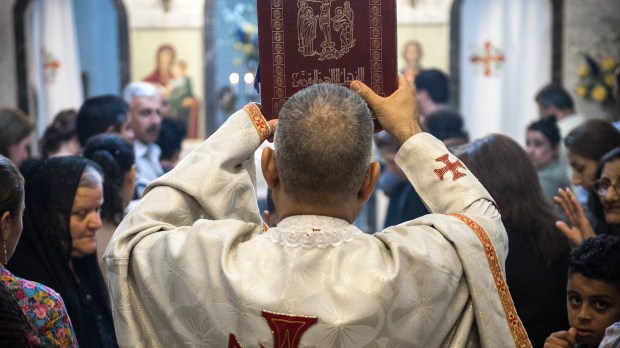When people talk about immigration helping to fill empty pews in Catholic churches in the United States, the images that comes to mind are of Mariachi masses and posada celebrations.
But two groups of new Catholic immigrants, who bring a very different sense to their liturgical celebrations, are growing fast enough that Pope Francis recently established new dioceses for them in North America.
And with church traditions deeply rooted in the Middle East and India, liturgies celebrated by these ethnic groups are quite out of this world.
On Jan. 3, the Holy Father erected the Eparchy of St. Mary, Queen of Peace, of the United States of America and Canada, for faithful of the Syro-Malankara Church, and appointed India-born Bishop Thomas Mar Eusebios Naickamparambil as its eparch. The new eparchy, equivalent to a diocese, was previously an exarchate, a sort of vicariate attached to a more established diocese.
Just four days later, Pope Francis erected the apostolic exarchate for Syriac Catholics in Canada with territory taken from the Eparchy of Our Lady of Deliverance of Newark, N.J. The Holy Father appointed a Lebanese priest, Father Antoine Nassif, as exarch.
In both cases, Francis is seeking to provide better pastoral care for Eastern Catholics, but the two groups come from very different backgrounds.
In the case of the Syro-Malankars, immigration from India to the U.S. began in the 1970s in response to job opportunities, particularly in health care. On the other hand, most Syriac Catholics coming to North America today are escaping war and persecution in Syria and Iraq, as did many in the 1980s, escaping the civil war in Lebanon, Father Nassif said in an interview.
Father Nassif will be known as Mar Boulos, or Bishop Paul, when he takes the reins of the new exarchate, based in Montreal. Born in Beirut in 1969 and ordained in 1992, he served most recently as rector of the Patriarchal Major Seminary of Charfet, Lebanon.
Michael J.L. LaCivita, communications director for the Catholic Near East Welfare Association (CNEWA), said the Syriac Catholic Church is small, with no more than 200,000 members worldwide. “Nearly half of these Catholics once made up two eparchies now largely shattered by [the Islamic State group]: Mosul in Iraq and Hassake in northeastern Syria,” he said. “In 2010, the eparchy based in Newark numbered fewer than 13,000 members. Today, some 25,000 Syriac Catholics live in North America. The fact that its size doubled in five years speaks of the growing need for pastoral oversight.”
In Canada, Father Nassif said, there are almost 3,000 families, or 20,000 faithful, belonging to this Church.
The Syro-Malankara Church is also relatively small, with no more than 500,000 faithful worldwide, said Atonement Father Elias D. Mallon, external affairs officer at CNEWA. The Church is one of two Eastern Catholic Churches based in the southern Indian state of Kerala.
“Our first mission started in the US in the early 1980s,” Bishop Eusebios said in an interview. “In 2001, St. John Paul II appointed an apostolic visitator, and in 2010 Pope Benedict established an apostolic exarchate, which is preliminary to an eparchy. Now the Holy See believes we can function as a diocese.”
Bishop Eusebios has been exarch since 2010. He will continue to be based in Elmont, Long Island, New York. The biggest concentration of Syro-Malankars is in the New York Tri-State area.
“The faithful are really enthusiastic about this,” Bishop Eusebios said. “We’ve gone from having a Syro-Malankara Mass once in a while to having our own eparchy.
There are about 11,000 people belonging to 16 parishes in the diocese, served by 18 priests. Now seeing its third generation in the U.S., the Church recently had its first U.S.-born priest ordained. Two other U.S.-born seminarians are in formation. They study at the local Roman Catholic diocesan seminary but receive additional formation in Syro-Malankar spirituality, liturgy and Eastern canon law. There is also an American-born woman entering a convent of Syro-Malankar sisters.
The two officials with CNEWA agreed that in addition to a desire to provide better pastoral care for these two Churches, Pope Francis has an affinity with Eastern Christianity because of its emphasis on “synodality.”
“Under Francis, the Synod of Bishops has become an important organ of the Catholic Church,” LaCivita said. “Synodality is something very familiar to Christians of the East — both Orthodox and Catholic. Francis might also be strengthening the synodal structure of Eastern Catholic Churches to vitalize them and to provide examples of synodality to Latin Catholics.”
He said that while a pope typically erects church jurisdiction outside the areas of the world where they come from, the recommendations and suggestions to do so come from the synods of those churches.
John Burger is news editor for Aleteia’s English edition.

